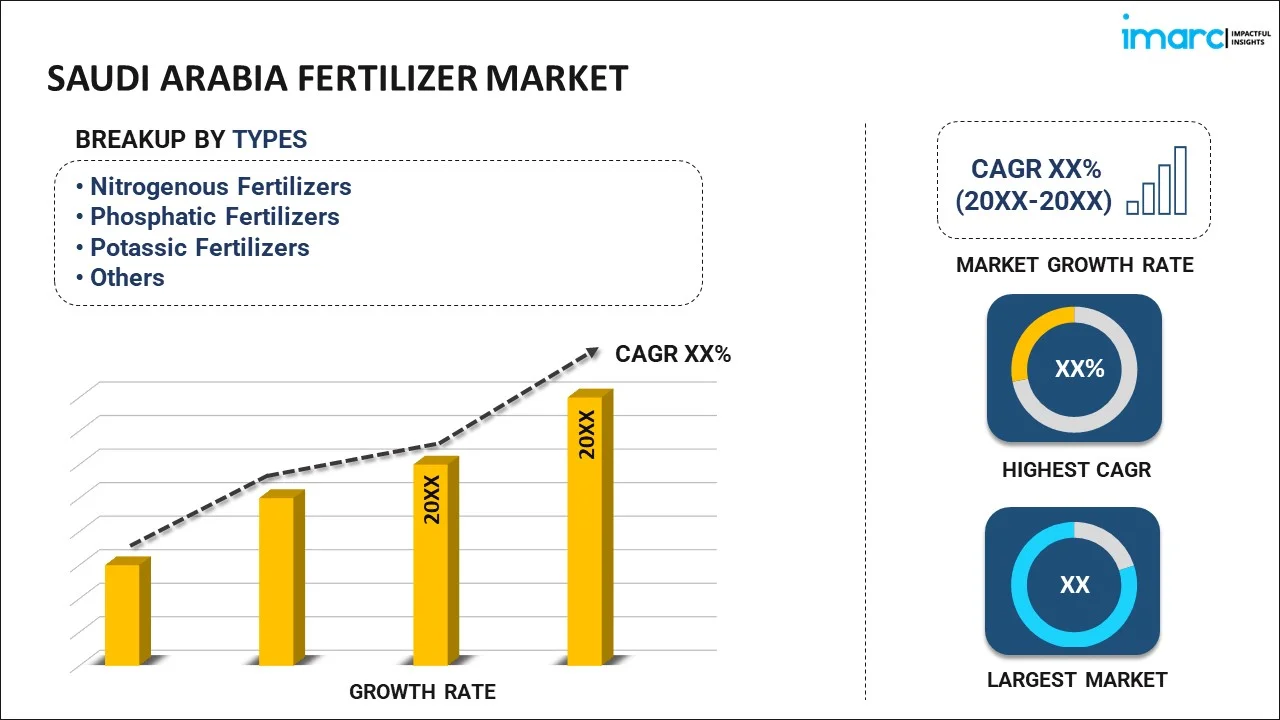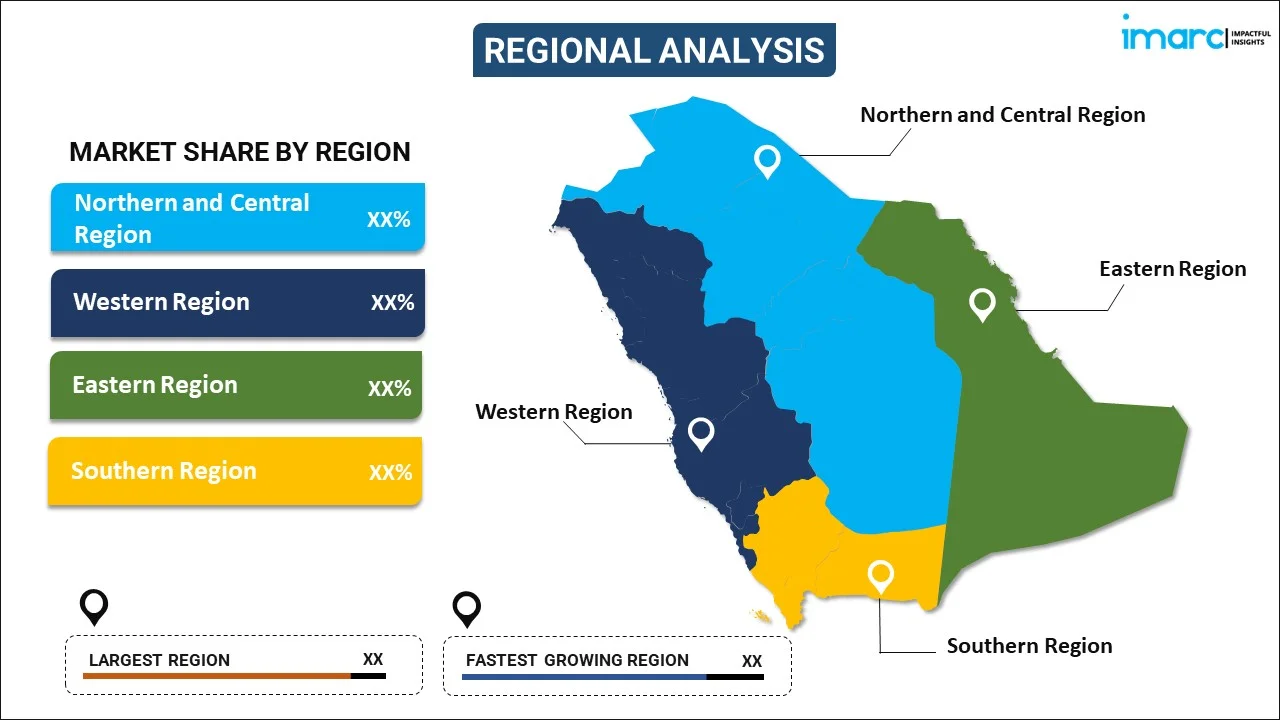
Saudi Arabia Fertilizer Market Report by Type (Nitrogenous Fertilizers, Phosphatic Fertilizers, Potassic Fertilizers, Secondary Macronutrient Fertilizers, Micronutrient Fertilizers), Application (Grains and Cereals, Pulses and Oilseeds, Fruits and Vegetables, and Others), and Region 2025-2033
Market Overview:
Saudi Arabia fertilizer market size reached USD 1,692 Million in 2024. Looking forward, IMARC Group expects the market to reach USD 2,999 Million by 2033, exhibiting a growth rate (CAGR) of 6.57% during 2025-2033. The increasing advances in fertilizer manufacturing techniques, precision agriculture, and biotechnology that have led to the development of more efficient and targeted fertilizers, are primarily driving the market.
|
Report Attribute
|
Key Statistics
|
|---|---|
|
Base Year
|
2024 |
|
Forecast Years
|
2025-2033
|
|
Historical Years
|
2019-2024
|
| Market Size in 2024 | USD 1,692 Million |
| Market Forecast in 2033 | USD 2,999 Million |
| Market Growth Rate (2025-2033) | 6.57% |
Fertilizers are essential components in modern agriculture, playing a crucial role in ensuring robust crop yields and food security. These chemical or organic substances are applied to the soil or plants to provide essential nutrients like potassium, nitrogen, and phosphorus, which are essential for plant growth. Fertilizers enhance soil fertility and promote healthier plant development, resulting in increased crop production. There are two main categories of fertilizers: synthetic (inorganic) and organic. Synthetic fertilizers are manufactured through chemical processes, offering precise control over nutrient composition, while organic fertilizers are derived from natural sources, including compost or animal manure. Both types have their advantages and disadvantages, with synthetic fertilizers typically providing a faster nutrient release and organic fertilizers improving soil structure and microbial activity. However, the excessive use of fertilizers can lead to environmental issues like water pollution and soil degradation. Striking a balance between improving agricultural productivity and minimizing environmental impacts is essential for sustainable farming practices.
Saudi Arabia Fertilizer Market Trends:
The fertilizer market in Saudi Arabia is influenced by several key drivers, which together shape its dynamics. Firstly, population growth is a significant factor. As the regional population continues to expand, there is an increasing demand for food production, leading to higher fertilizer usage. Additionally, urbanization plays a pivotal role in this context. As more people move to urban areas, the available arable land per capita decreases, necessitating the use of fertilizers to enhance crop yields. Moreover, changing dietary habits have a direct impact. As individuals shift towards diets that require more grain-intensive animal agriculture, the need for fertilizers to produce animal feed crops rises. Concurrently, climate change is becoming a prominent driver. Erratic weather patterns and extreme events necessitate the use of fertilizers to optimize crop resilience and adaptability. Furthermore, the emerging popularity of precision agriculture techniques, enabled by digital technology and data analytics, that help in promoting efficient fertilizer application is expected to drive the market in Saudi Arabia.
Saudi Arabia Fertilizer Market Segmentation:
IMARC Group provides an analysis of the key trends in each segment of the market, along with forecasts at the country level for 2025-2033. Our report has categorized the market based on type and application.
Type Insights:

- Nitrogenous Fertilizers
- Urea
- Calcium Ammonium Nitrate
- Ammonium Nitrate
- Ammonium Sulfate
- Anhydrous Ammonia
- Others
- Phosphatic Fertilizers
- Mono-ammonium Phosphate (MAP)
- Di-ammonium Phosphate (DAP)
- Single Super Phosphate (SSP)
- Triple Super Phosphate (TSP)
- Others
- Potassic Fertilizers
- Muriate of Potash (MOP)
- Sulfate of Potash (SOP)
- Secondary Macronutrient Fertilizers
- Micronutrient Fertilizers
A detailed breakup and analysis of the market based on the type have also been provided in the report. This includes nitrogenous fertilizers (urea, calcium ammonium nitrate, ammonium nitrate, ammonium sulfate, anhydrous ammonia, and others), phosphatic fertilizers (mono-ammonium phosphate (MAP), di-ammonium phosphate (DAP), single super phosphate (SSP), triple super phosphate (TSP), and others), potassic fertilizers {muriate of potash (MOP) and sulfate of potash (SOP)}, secondary macronutrient fertilizers, and micronutrient fertilizers.
Application Insights:
- Grains and Cereals
- Pulses and Oilseeds
- Fruits and Vegetables
- Others
The report has provided a detailed breakup and analysis of the market based on the application. This includes grains and cereals, pulses and oilseeds, fruits and vegetables, and others.
Regional Insights:

- Northern and Central Region
- Western Region
- Eastern Region
- Southern Region
The report has also provided a comprehensive analysis of all the major regional markets, which include Northern and Central Region, Western Region, Eastern Region, and Southern Region.
Competitive Landscape:
The market research report has also provided a comprehensive analysis of the competitive landscape in the market. Competitive analysis such as market structure, key player positioning, top winning strategies, competitive dashboard, and company evaluation quadrant has been covered in the report. Also, detailed profiles of all major companies have been provided.
Saudi Arabia Fertilizer Market Report Coverage:
| Report Features | Details |
|---|---|
| Base Year of the Analysis | 2024 |
| Historical Period | 2019-2024 |
| Forecast Period | 2025-2033 |
| Units | Million USD |
| Scope of the Report | Exploration of Historical Trends and Market Outlook, Industry Catalysts and Challenges, Segment-Wise Historical and Future Market Assessment:
|
| Types Covered |
|
| Applications Covered | Grains and Cereals, Pulses and Oilseeds, Fruits and Vegetables, Others |
| Regions Covered | Northern and Central Region, Western Region, Eastern Region, Southern Region |
| Customization Scope | 10% Free Customization |
| Post-Sale Analyst Support | 10-12 Weeks |
| Delivery Format | PDF and Excel through Email (We can also provide the editable version of the report in PPT/Word format on special request) |
Key Questions Answered in This Report:
- How has the Saudi Arabia fertilizer market performed so far and how will it perform in the coming years?
- What has been the impact of COVID-19 on the Saudi Arabia fertilizer market?
- What is the breakup of the Saudi Arabia fertilizer market on the basis of type?
- What is the breakup of the Saudi Arabia fertilizer market on the basis of application?
- What are the various stages in the value chain of the Saudi Arabia fertilizer market?
- What are the key driving factors and challenges in the Saudi Arabia fertilizer?
- What is the structure of the Saudi Arabia fertilizer market and who are the key players?
- What is the degree of competition in the Saudi Arabia fertilizer market?
Key Benefits for Stakeholders:
- IMARC’s industry report offers a comprehensive quantitative analysis of various market segments, historical and current market trends, market forecasts, and dynamics of the Saudi Arabia fertilizer market from 2019-2033.
- The research report provides the latest information on the market drivers, challenges, and opportunities in the Saudi Arabia fertilizer market.
- Porter's five forces analysis assist stakeholders in assessing the impact of new entrants, competitive rivalry, supplier power, buyer power, and the threat of substitution. It helps stakeholders to analyze the level of competition within the Saudi Arabia fertilizer industry and its attractiveness.
- Competitive landscape allows stakeholders to understand their competitive environment and provides an insight into the current positions of key players in the market.
Need more help?
- Speak to our experienced analysts for insights on the current market scenarios.
- Include additional segments and countries to customize the report as per your requirement.
- Gain an unparalleled competitive advantage in your domain by understanding how to utilize the report and positively impacting your operations and revenue.
- For further assistance, please connect with our analysts.
 Inquire Before Buying
Inquire Before Buying
 Speak to an Analyst
Speak to an Analyst
 Request Brochure
Request Brochure
 Request Customization
Request Customization




.webp)




.webp)












